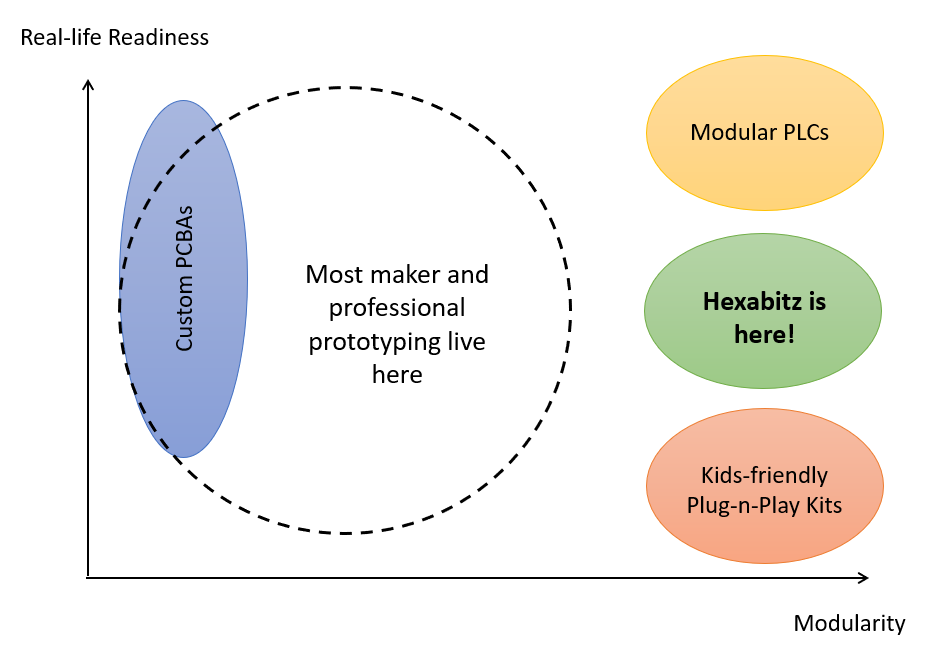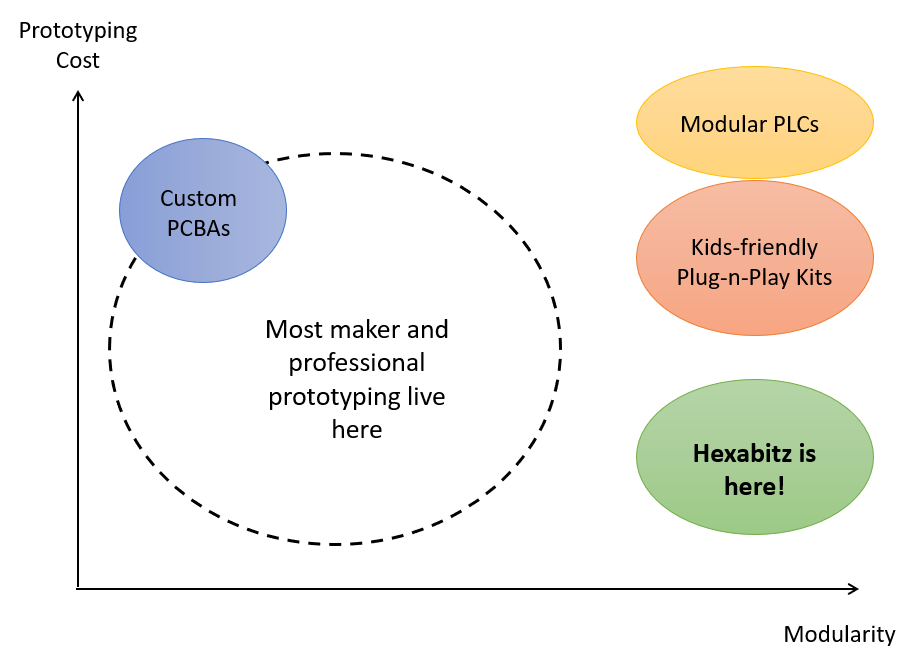A Void in The Market
One might think the hardware prototyping scene is quite saturated and does not accommodate new platforms. Yes and no. There's definitely a large number of platforms and options out there-which is a good thing because it enables people to innovate. However, if you look at available prototyping solutions from a different perspective, you will spot a good deal of clustering and a void in the market, which is where the need for systems like Hexabitz come from.

There has always been a trade-off between modularity and system's ability to support real life applications, i.e., being rigid, compact, lightweight and reliable. Although you can't combine both, current options are really limiting: you either have to settle for jungles of wires and stacked boards or build a one-time-use compact and rigid PCBA. At the two extremes, you also have a bunch of really nice modular plug-n-play solutions that are geared toward K12 and STEM education and there's the high performance, very expensive modular PLCs and industrial card-based systems. We found our sweet spot just in between! We think platforms such as Hexabitz can provide a great deal of modularity and at the same time be lightweight, rigid and compact enough to fit many in-field prototyping scenarios. It's why we focus in our platform on horizontal integration because that's how electronics and PCBAs are made in general and thus, the best form factor for many applications.
If you plot prototyping cost per unit there is another clear void. Custom-made PCBAs are usually expensive and time-consuming for small prototyping quantities. Since Hexabitz design is bare-bones, i.e., consisting of electronics and PCBs only, the cost per module can be driven down significantly at mass production enabling lower costs for prototypes and still better form-factor and rigidness than most other solutions.

But Does It Really Matter?
Why do we even need modular prototyping? Well, with 41.8 million tons of e-waste generated in 2014 and 50+ expected this year, there's enough electronics waste destroying our planet (less than 15% gets recycled)! One might say, this is mostly production waste and prototyping amounts to a minuscule part. This is true, however, makers, hobbyists and engineers consume much more PCBAs than the average consumer. We're all at fault to some degree-including myself. A typical maker might have dozens or even hundreds of custom-made PCBAs collecting dust from all sorts of projects and prototypes. With the impressive year-over-year growth of the maker movement, exemplified by the growth of Hackaday community itself and the following graph illustrating Maker Faire growth (re-purposed from here), this doesn't look sustainable!

We definitely do not call on people to abandon custom PCB design and prototyping. It's always an educational experience and lots of fun. Many times designing your own is really the only solution. However, there are definitely many occasions where you can settle down for a modular prototype.
With Hexabitz, you still get the fun of building something with your own hands when you design your own shape and solder the modules. After you're done with the project and when it starts collecting dust on your shelf, all you need is to dis-assemble the modules and reuse them again-re-cabbing your investment! If you don't have the skills or time to design professionally looking custom boards, you can still satisfy your inner-nerd and save the environment (and your pocket as well) ;-)
The Truth About Modular Electronics
You might say modular electronics projects had mixed results so far (a.k.a. failed), which is true to some extent. We personally believe many people are looking in the wrong direction. Electronics can be generally divided into two categories:
- User-facing (front-end) Electronics: These gadgets must be extremely streamlined to the user experience. They must be the lightest, the smallest, the cheapest and the most beautiful a device can be. This goes directly against modularity. Modularity, by definition, adds overhead and overhead is not bearable in such devices. Examples include smart phones, watches, wearables, consumer-facing gadgets, etc.
- Non User-facing (back-end) Electronics: These devices have less constraints for size, weight or form-factor. Users are not in direct contact with such devices. Examples include electronics inside your elevator, car, washing machine, air conditioner, etc.
Front-end devices cannot be modularized because this severely affects their functionality. Most people don't like if their phone or watch is modular but also bulky, heavy or ugly. Who are we kidding here? People won't stop buying new phones because they've got a modular one! People buy new gadgets because they like to show off.
On the other hand, back-end devices can be modularized to some extent. People don't care how the electronics inside their washing machine actually look like and many will be quite happy to know they're buying a washing machine or a fridge or car with modular and reusable electronics. It's a tough problem designing things in a modular fashion and guaranteeing quality. But If manufacturers get it right, there is a chance at least a small percentage can be reused across different products (or rebuilt into refurbished / lower-grade units).
So why everyone is building modular phones and watches? Seems like there's a new project everyday. You might say because they have the biggest impact on the environment. That's exactly the contrary. According to United Nations research study, Small IT e-waste- the category that includes phones and similar items was only 3 million tonnes in 2014, while large and small equipment (most other household items) amounted to 24.6 million tonnes combined!
Yes! Building a boring and non-flashy modular back-end electronics device is 8 times more probable to save the environment than a flashy and sexy modular phone or watch or wearable. So please no more modular phones and watches and let's focus our attention and resources into the back-end- all those boring and forgettable devices where endless opportunities for modularization exist.
Do you have you a similar / different opinion about this matter? Feel free to share with us your comments and ideas below!
 Hexabitz
Hexabitz
Discussions
Become a Hackaday.io Member
Create an account to leave a comment. Already have an account? Log In.